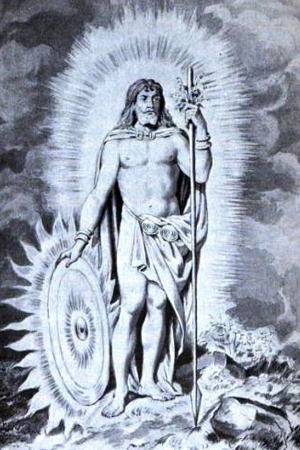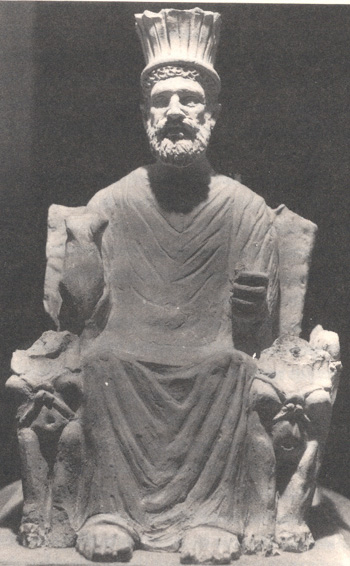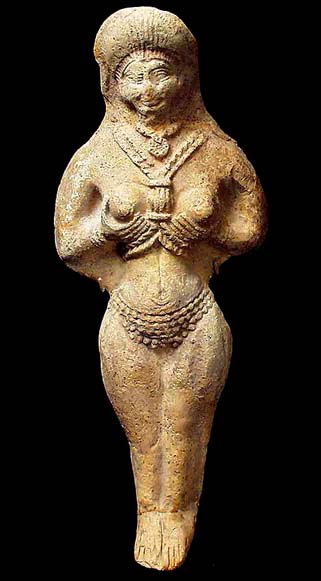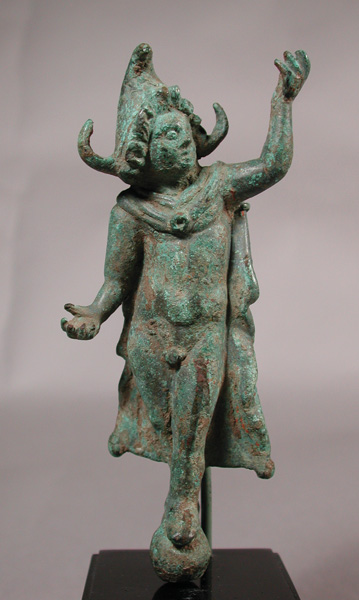 Spring keeps trying to arrive but this bitter winter refuses to give up just yet. Our nationwide longing to be liberated from the tyrannical grip of winter made this a good time to examine some of the ancient myths about winter and the coming of spring. The celebration of those myths at this time of year plus the fact that many of those myths centered around dead and resurrected deities necessitated Christianity’s attempt to superimpose its OWN dead and resurrected deity over top of those older stories. Hence the celebration of Easter in springtime. (And it’s not just Christianity that behaved that way – other religions also would superimpose their own celebrations over top of those held in honor of the previously dominant gods in their region. I’ll cover the behavior of those other belief systems – especially Islam and the Incan faith – another time.)
Spring keeps trying to arrive but this bitter winter refuses to give up just yet. Our nationwide longing to be liberated from the tyrannical grip of winter made this a good time to examine some of the ancient myths about winter and the coming of spring. The celebration of those myths at this time of year plus the fact that many of those myths centered around dead and resurrected deities necessitated Christianity’s attempt to superimpose its OWN dead and resurrected deity over top of those older stories. Hence the celebration of Easter in springtime. (And it’s not just Christianity that behaved that way – other religions also would superimpose their own celebrations over top of those held in honor of the previously dominant gods in their region. I’ll cover the behavior of those other belief systems – especially Islam and the Incan faith – another time.)
Not all seasonal myths conformed to the following pattern. I’m limiting this list to the ones that did.
PERSEPHONE
Pantheon: Greek (The Romans called her Proserpine)
The Tale: Persephone was the beautiful daughter of the goddess Demeter (Ceres to the Romans). Persephone caught the eye of Hades, the god who ruled over the realm of the dead. Overcome with lust Hades (Pluto to the Romans) emerged from his subterranean domain and stole Persephone away to his realm to become his Queen.
The Savior: Demeter went searching for her daughter throughout the world, often assuming the form of a mortal woman. Her search wore on and on with no results, causing Demeter to fall more and more deeply into despair. Because she was the goddess of nature that despair manifested itself in colder weather, in the leaves falling off the trees, other vegetation dying and some animals hibernating or migrating to flee the cold.
As this first winter wore on, human beings began praying to Demeter to restore the world’s greenery and the warmer temperatures of the past. In her overwhelming sadness at the loss of her daughter Demeter ignored those prayers, prompting humans to begin praying to the other gods to intercede on humanity’s behalf. At length Zeus, the sky god who ruled over all the gods in the Greek pantheon, realized that the only way to end Demeter’s despair and end the terrible winter was to find her daughter Persephone and reunite mother and daughter.
Learning that Hades was holding Persephone against her will in the Underworld Zeus let Demeter descend into that land of the dead to retrieve her daughter. When Demeter arrived before the throne of Hades and relayed Zeus’ command that he release Persephone the devious god of the dead exploited a loophole: Persephone was free to go only if she had refused all food and drink while being held in captivity. (Accepting food and drink would constitute an acceptance of Hades as her husband and his realm as her new home)
As everyone knows Persephone in her hunger had eaten a pomegranate (or in some variations just three pomegranate seeds). This meant she could not leave the Underworld permanently but in concession to the tiny quantity of food she had eaten Zeus decreed that Persephone would only have to stay in the Underworld as Hades’ wife three months out of the year.
Demeter never quite reconciled herself to this decision and so, each year when Persephone must depart for the Underworld for her three- month stay Demeter again lets nature figuratively “die” for the three months we know as winter. When Persephone returns from the land of the dead, nature is reborn and Persephone is hailed as the goddess of Spring. In some variations Persephone must spend half the year in the Underworld and that’s how those myths account for the way vegetation begins to “die” in the Autumn.
Even before the man called “Saint” Paul Hellenized whatever the original teachings of Jesus may have been the theme of a dead and reborn deity had already fused itself to certain Spring celebrations. These celebrations often spawned cultic offshoots which over time became separate faiths themselves. Those faiths were called “Mystery Religions” and include Christianity, though many Christians would be loathe to admit it.
The Eleusinian Mysteries were celebrated at Eleusis and centered around the tale of Persephone (and nature) being rescued from the Underworld by Demeter. These Mysteries were exclusively for women the way that various dead and resurrected male deities became the central figure of Mysteries reserved exclusively for men. (And all of them MAY be traceable to influences from ancient Sumer depending on which sources you believe.)
Pantheon: Norse
The Tale: The god of light Baldur was the son of Odin and Frigga. He was so attractive and personable that he was beloved by everyone and was considered the most handsome of the gods. Naturally Loki, the premier trouble-maker in Norse mythology, resented Baldur because of all his good qualities but dared not strike against Baldur directly lest he invite the wrath of Odin, the King of the Norse gods. While Loki plotted Baldur’s mother Frigga had a nightmare about harm befalling Baldur.
Troubled by this premonition Frigga roamed the world, and, as the goddess of nature, extracted a vow from all living things, both plant and animal, and all UNliving things like rocks and metals, that they would NEVER do any harm to her son Baldur. All things living and unliving agreed, so Frigga slept easier believing her son to be safe. Foolishly she had failed to extract such a vow from mistletoe, believing it to be too harmless to ever injure Baldur. (I know that’s incredibly stupid of her, but you know mythology)
Many of the Norse gods in Asgard were having fun with this state of affairs, throwing rocks and various pieces of wood at Baldur, all of which, because of their vow, merely glanced off him harmlessly while the god of light laughed heartily. Loki (who was spying on Frigga when she refrained from having mistletoe promise to never harm Baldur) saw his chance and manipulated Baldur’s blind brother Hodur, the god of darkness, to join in the fun. Loki slipped a sharpened shaft of mistletoe (which you’d still think would be harmless but again – mythology) into Hodur’s hand and, guiding his aim at Baldur, let him throw it.
This glorified version of a “pointed stick” (for you Monty Python fans) pierced Baldur’s heart, killing him. (Plenty of gods from pantheons around the world “die” and wind up in the realm of the dead, often as its ruler- like Osiris and Izanami) Odin’s son Vali, thinking Hodur was to blame, drew his sword and “killed” Hodur, who joined Baldur in the land of the dead.
The Savior: Frigga was in such despair over Baldur’s death that her sadness manifested itself in colder weather and the death of vegetation, etc. Humanity prayed for deliverance from the oppressive cold and the lack of fruits, game and vegetables but Frigga ignored them. They prayed to the other gods and finally Odin interceded.
He learned that Hel, the goddess who ruled over the land of the dead, was not inclined to release Baldur unless everything living and unliving mourned for him. Frigga once again roamed the world, extracting a statement from all things living and unliving that they mourned for Baldur. A female Jotun (giant) refused to mourn Baldur because he killed her husband, though in some versions this Jotun turns out to have been Loki in disguise.
Because all things living and unliving do NOT therefore mourn Baldur’s death Hel decrees that she will NOT release him. In the version of this story that bears marks of Christian influence the story goes that Baldur will only return from Hel’s domain after the end of the world on the day of Ragnarok, when most of the gods are destroyed in the final battle between good and evil. Baldur will then be the chief deity of that new world and lead the gods who rule over that new world. (Similar to Christian tales of Jesus returning and “ruling” after the end of the world)
In pre-Christian versions of this myth it is speculated that Baldur was permitted to leave the land of the dead for part of each year just like Persephone was. I definitely go along with that notion since it reflects the pattern of many other seasonal myths and also goes along with Baldur’s oft-cited role as the god of “light”. In the far, far north the return each year of the “light-dominant” months would have been even more of a cause for celebration than it is here in the part of the world where the nights NEVER get as long as they do in the far north during winter. Those dark nights would have been perfectly represented by Baldur’s brother, Hodur, the blind god of darkness.
Other assertions are made that the pre-Christian version of this myth depicted Frigga wanting both her sons – Baldur AND Hodur – released from the land of the dead. Hel compromised, allowing each son out for roughly half the year: Baldur for the months when daylight grew stronger and Hodur for the months when darkness grew stronger.
This is presented as the likely resolution to the version in which Mistletoe is a sword which can see on its own and is used by Hodur to kill Baldur. After Hodur was slain by Valli the sword Mistletoe was thrust into the ground, never to be used again, and ultimately became the first Mistletoe tree.
Since all this happened because of the brothers’ rivalry over Nanna the arrangement was that whichever brother was outside of Hel’s domain was Nanna’s mate while the other was the lover of the goddess Hel. And this mate-swapping repeated seasonally every year until the Fimbulwinter signaled the approach of Ragnarok.
Pantheon: Canaanite
The Tale: Baal, the storm god of the Canaanites, had emerged triumphant in his war with the sea god Yam and became very hubristic. He insisted he had authority even over Mot, the god of death and warned Mot that the only places on Earth that he could visit were the deserts. Infuriated, Mot invited/ dared Baal to visit him in his subterranean realm, the land of the dead. Baal accepted the dare/ invitation lest he lose face and once there Mot fed him the food of the dead – mud – thereby trapping Baal in the Netherworld.
With Baal thus imprisoned no rains fell on the Earth and drought consumed the world, killing vegetation and the animals who fed on that vegetation, then the animals who fed on THOSE animals, etc. In an interesting variation on these other seasonal myths in the story of Baal the “dead season” is not winter but summer, which, given the intense heat in that part of the world, was potentially more destructive to nature than winter.
The Savior: Humans prayed to the goddess Anat – Baal’s wife – to return the rains to the Earth. Anat prayed to the other gods to intercede with Mot to release Baal but they refused. Finally, missing her husband terribly, Anat descended into the Netherworld to plead with Mot directly. Mot still refused to release Baal and so the infuriated Anat battled the god of death, ultimately defeating him. She slashed him so badly with her stone knife that he was helpless to prevent her liberation of Baal.
The rains were thus restored to the Earth, but because he had eaten of some of the food of the dead while in Mot’s domain Baal was required to spend part of every year in the Netherworld. This would once again prevent the cooling winds and rain during the summer months, allowing the symbolic “death” of nature.
At summer’s end Baal would return from the land of the dead and would unleash the rains in order to restore fertility to the land.
Pantheon: Sumerian (The Babylonians called her Ishtar)
The Tale: Inanna the fertility goddess and queen of the heavens was looking to extend her reign to the land of the dead. She descended into the Netherworld, which was ruled over by her sister, the goddess Ereshkigal. Fighting on the death goddess’ own turf was foolish and Ereshkigal won the controntation and either nailed Inanna to a wall of her palace or impaled her on a stake, Vlad the Impaler style.
With Inanna thus imprisoned, vegetation died from the withering heat of summer, which could get even worse in that part of the world, where droughts could be so intense that the Tigris and Euphrates rivers were the only bodies of water that would NOT get dried up. The usual drought cycle continued, with vegetation dying, then animals who lived off it dying, etc. In the case of Inanna her dominion over sexual fertility also added the angle that males and females of all species lost all interest in sex and reproduction as well.
The Savior: In this case it’s more of a substitute than a savior. Ereshkigal eventually decreed that Inanna could leave the Netherworld for part of the year if she could find a substitute to take her place for that part of the year. Inanna emerged from the land of the dead and learned that her lover, the shepherd and date (as in the fruit) god Dumuzi (called Tammuz by the Babylonians) had been unfaithful to her in her absence. In her anger she decreed that HE would be her substitute and so her sister’s demons dragged Dumuzi to the Netherworld.
Naturally when Inanna’s time in the Netherworld returned each year the heat of summer caused the “death” of nature, etc. Eventually Ereshkigal fell in love with Dumuzi as well, so she and Inanna reached a new agreement: Inanna would no longer have to stay in the Netherworld for part of the year if she would permit Dumuzi to become Ereshkigal’s lover during the part of the year that HE was imprisoned in the Netherworld. From then on the death of nature in summer was caused by Inanna’s grief over missing her lover Dumuzi when he was in the land of the dead with her sister.
Pantheon: Greek/ Syrian /Lebanese /Cyprian overlap
The Tale: Adonis, the epitome of male beauty in the myths that involve him, was the son of Myrrha, the goddess of myrrh trees. The multiple variations regarding who his father was would consume far too much space and take us outside the parameters of this article. Being born of a myrrh tree Adonis already had attributes of a vegetation god but was most famed as a hunter. And not just any type of hunter, but the kind who would bring in his quarry alive for later sacrificial rituals. (This is why I tie Adonis into the Zagrean tradition in my own theory but for simplicity’s sake I’ll refrain from elaborating at this time)
The goddess Artemis grew envious of Adonis’ hunting skill and created a supernatural boar which, when Adonis tried to capture it, gored him to death. His mother Myrrha convinced her sister vegetation deities (all of whom also loved Adonis for his physical perfection) into mourning his loss with her and vegetation died, etc. Aphrodite, one of Adonis’ lovers, also mourned him and in her grief caused men and women and other animals to lose the urge to procreate.
The Savior: Aphrodite descended to the land of the dead to retrieve Adonis for herself and all other women who mourned his loss. Persephone, the Queen of the dead, had taken Adonis as her lover and did not want to let him go. Zeus was called upon to intercede in the matter and (no doubt feeling a certain deja vu) decreed that Adonis would spend the winter months in Hades with Persephone and the rest of the year with Aphrodite (or in some versions a third of the year with each of those two goddesses and the other third with his mother Myrrha. All together now: Eeewww.)
Insert the usual familiar pattern by now- the “death” of nature during Adonis’ absence and its return when he was freed from the land of the dead each spring. A new wrinkle with Adonis is the way the Adonis River in what is now Lebanon runs red with “the blood of Adonis” each spring. (it’s really a red tinge caused by anemone leaves)
Pantheon: Phrygian
The Tale: Attis was the vegetation god (but was especially associated with pine trees) and was born of the Earth and mother goddess Cybele. He and Cybele became lovers and this explained why vegetation grew out of the soil. In some versions the mountain god Agdistis is considered his father but in other versions Agdistis is a goddess and is conflated with Cybele herself.
At one point Attis was being sexually pursued by a demon and, either out of a desire to remain faithful to Cybele or out of repugnance at the demon’s hideousness Attis castrated himself with a boar’s tusk to end the attempted seduction. Unfortunately Attis bled to death from the self-inflicted wound and nature died with him.
The Savior: Cybele descended into the land of the dead, which had begun to blossom with all manner of vegetation due to the presence of Attis, whose spiritual form still retained his manhood – and therefore his fertility/ virility.
Since the land of the dead now desired vegetation too, the arrangement was made that Attis would spend part of the year above ground with Cybele and part of the year in the subterranean land of the dead.
When Attis was in the Underworld vegetation on the surface “died” etc and was reborn with his return in Spring. Attis’ departure from the land of the dead caused the death of vegetation there.
Priests of Attis were known for ritually castrating themselves to enter his service. This act of self-mutilation was not only done in imitation of the god’s self-castration but also symbolized the initiate’s renouncing of their ties to sexuality. Much later when worship of Attis spread to other parts of the world such acts were replaced by simple vows of celibacy.
OSIRIS – Given the popularity of Egyptian mythology I’m assuming most people are familiar with Osiris’ death and dismemberment at the hands of his brother Set and his resurrection thanks to Isis. Egypt’s “Abydos Passion Play” is so well-known I find it hard to believe I need to elaborate on this one.
DIONYSUS – The Dionysiac myths that parallel the stories of these other dead and resurrected deities are mostly from the Orphic offshoot of mainstream Greek myths, and I will be examining all of those in great detail in the near future. Too much space would be needed to do the dead and reborn Dionysus justice so it is better suited to a full article of its own.
AMATERASU – I strongly disagree with sources who try to make a seasonal myth out of the Shinto myth of Amaterasu hiding and later being coaxed out of a cave. Her disappearance and reemergence was depicted as a one-time weather trauma, not a recurring event. Therefore I feel it has much more in common with ancient flood myths, which were also depicted as one-time events and not recurring phenomena.
IZANAMI – Okay, people are a little closer with the Shinto myth of the goddess Izanami in Yomi, the land of the dead, since her husband Izanagi DOES follow her there to try to bring her back. But since she NEVER leaves the land of the dead (in fact Izanagi is forced to bar her way) I disagree with people who try to depict this as a seasonal myth, too. In the future I’ll examine myths from many obscure Pacific island pantheons to support my own contention that the story of Izanami and Izanagi originated as an incest taboo myth.
FOR SIMILAR ARTICLES AND MORE OF THE TOP LISTS FROM BALLADEER’S BLOG CLICK HERE: https://glitternight.com/top-lists/
© Edward Wozniak and Balladeer’s Blog 2014. Unauthorized use and/or duplication of this material without express and written permission from this blog’s author and/or owner is strictly prohibited. Excerpts and links may be used, provided that full and clear credit is given to Edward Wozniak and Balladeer’s Blog with appropriate and specific direction to the original content.






Oh my…thank God I am human
Ha! I know what you mean!
Very interesting! I knew about Persephone and Osiris but not the others.
Thank you!
Very informative!
Thank you!
Why do u spread hate about Islam?
You gutless piece of shit I do critical examinations of the mythology underlying all religions. Gutless worms like you fixate on Islam because you are far too cowardly to ever say anything critical of Islam but you’ll bash Christianity out the ass. When pieces of garbage like you can provide me links to threads where you jump in to defend Christianity by accusing its critics of spreading “hate” we’ll talk. Until then I’m dismissing you with the type of treatment a shit-spined asshole like you deserves.
Very very awesome! I only ever knew about Adonis as a hot guy, too, not a resurrected god.
Thanks! Always glad to spread the word!
Love the Inanna story!
Glad to hear it! Feel free to spread the word!
This sounds like Satanism to me.
No, it is nothing at all like that.
Pingback: BAAL: DEATH AND RESURRECTION | Balladeer's Blog
logged.
Great Blog. Really enjoyed reading.
Thanks.
Nice index of these!
Thanks!
I really enjoy the depth you bring to these ancient myths and stories!
Thank you very much for saying so!
Excellent piece of comparative mythology.
Thank you.
You drew some excellent comparisons here.
Thank you.
I really enjoy your comparative mythology posts.
Thank you.
Wonderful comparative mythology!
Thank you!
Scary and Satanic.
There’s nothing Satanic about it. Besides, I think Satanists are idiots. Especially the ones who go to all that RenFest dweeb effort and then try to put on those “too cool for school” airs by saying “But we don’t really MEAN any of this, dude!” They still look like complete jackasses.
I am totally into Inanna now!
That is good to hear.
Your blog is more educational than my college mythology courses were.
Thank you very much.
You painted such lovely pictures with your descriptions of these myths.
Thank you very much.
You are the Joseph Campbell of blogging.
Thank you.
Inanna is so majestic!
I know what you mean.